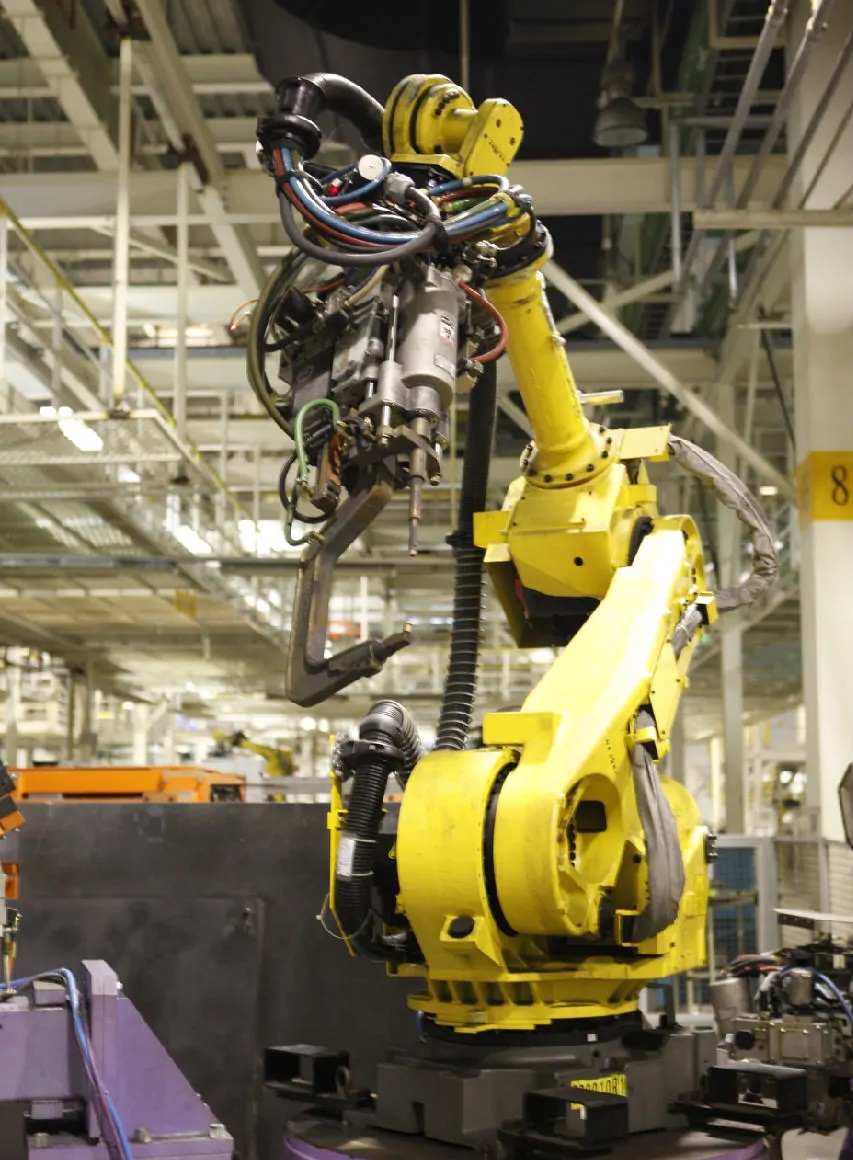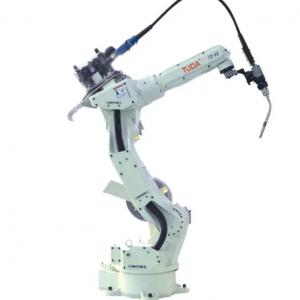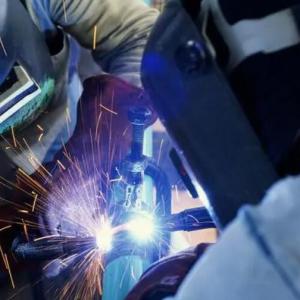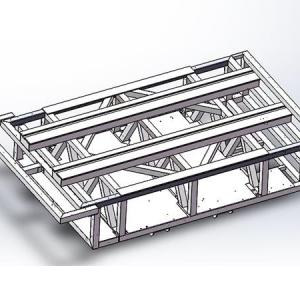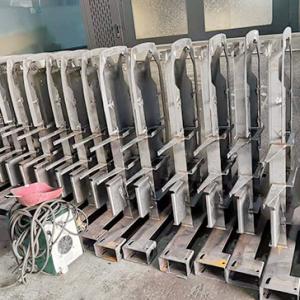Purpose and scope of application of welding robots
Purpose and scope of application of welding robots
Workstation (unit)
This system is the simplest if the workpiece does not need to be displaced throughout the welding process, and the fixture can be used to position the workpiece on the work surface. However, in actual production, more workpieces need to be displaced during welding, so that the weld is welded in a better position (attitude). In this case, the positioner and the robot can move separately, that is, the robot is re-welded after the positioner is positioned; it can also be moved simultaneously, that is, the positioner is displaced while the robot is welded, which is often referred to as displacement. Machine and robot coordinate movement. At this time, the movement of the positioner and the movement of the robot are combined, so that the movement of the welding torch relative to the workpiece can not only meet the welding seam trajectory but also meet the requirements of welding speed and welding torch posture. In fact, the axis of the positioner has become an integral part of the robot at this time, and this welding robot system can have as many as 7-20 axes, or more. The latest robot control cabinet can be a combination of two robots with 12 axes of coordinated movement. One of them is a welding robot, and the other is a handling robot as a positioner.
The welding robot workstation is further subdivided, and the following four can be obtained:
1.1 The box welding robot workstation is a special equipment for the robot workstation developed for box welding with large production volume and high welding quality and size requirements in the cabinet industry.
The box welding robot workstation consists of an arc welding robot, a welding power source, a welding torch wire feeding mechanism, a rotary double-position positioner, a fixture and a control system. The workstation is suitable for the welding of various box-type workpieces. The automatic welding of various types of boxes can be realized by using non-stop fixtures in the same workstation, and the relative position of the welding is high. Due to the use of a double-station positioner, the workpiece can be disassembled and assembled at other stations during welding, which greatly improves the welding efficiency. Due to the use of MIG pulse transfer or CMT cold metal transfer welding process for welding, the heat input during the welding process is greatly reduced, and the product is not deformed after welding. The welding seam is beautiful, especially for the stainless steel gas chamber with high sealing requirements, the gas in the gas chamber is guaranteed not to leak after welding. By setting the variety selection parameters in the control system and changing the work fixture, automatic welding of multiple varieties of boxes can be realized.
Using arc welding robots of different working ranges and positioners of corresponding sizes, the workstation can meet the welding requirements of various cabinets with a welding seam length of about 2000mm. The welding speed is 3-10mm/s. According to the basic material of the box, the welding process adopts different types of gas shielded welding. The workstation is also widely used in electric power, electrical, machinery, automobile and other industries.
1.2 The stainless steel gas chamber robot flexible laser welding processing equipment is a flexible robot laser welding processing equipment developed for the welding of box-type workpieces with relatively large welding deformation of stainless steel and high sealing requirements. The processing equipment is composed of a robot, a laser generator unit, a water cooling unit, a laser scanning tracking system, a flexible positioner, a fixture, a safety guardrail, a vacuum device and a control system. By setting the variety selection parameters in the control system And replace the fixture, can realize automatic welding of various types of stainless steel air chamber workpieces.
1.3 The shaft welding robot workstation is a special equipment specially developed for the shaft welding in the universal circuit breaker in the low-voltage electrical industry. A set of special shaft welding robot workstation has been introduced.
The shaft welding robot workstation is composed of arc welding robot, welding power source, welding torch wire feeding mechanism, rotary double position positioner, tooling fixture and control system. This workstation is used for welding various types of workpieces with the rotating shaft as the base (with several cantilevers placed on it). The automatic welding of various types of rotating shafts can be realized by using different fixtures in the same workstation. The welding position accuracy is very high. Due to the use of a double-station positioner, other stations can disassemble and assemble workpieces during welding, which greatly improves the efficiency.
Technical indicators: The diameter of the rotating shaft: Ф10-50mm, the length is 300-900mm, the welding speed is 3-5mm/s, the welding process adopts MAG mixed gas shielded welding, the positioner rotates, and the positional accuracy reaches 0.05mm.
It is widely used in high-quality and high-precision welding of various workpieces with rotating shafts, and is suitable for electric power, electrical, machinery, automobile and other industries. If manual arc welding is used for shaft welding, the labor intensity of workers is extremely high, the consistency of products is poor, and the production efficiency is low, only 2-3 pieces per hour. After using the automatic welding workstation, the output can reach 15-20 pieces/hour, and the welding quality and product consistency are also greatly improved.
Shaft Welding Robot Workstation Low Voltage Electrical Rotary Shaft
1.4 Robotic welding stud workstation
Robot welding stud workstations use robots to weld studs to workpieces for studs with different specifications on complex parts. The workstation is mainly composed of robot, stud welding power source, automatic nail feeding machine, robot automatic stud welding gun, positioner, tooling fixture, automatic gun changing device, automatic detection software, control system and safety guardrail. The machine sends the studs to the robot automatic welding gun, and through programming the path taught by the robot on the workpiece, the studs of different specifications are welded to the workpiece. The stud can be firmly welded to the workpiece by energy storage welding or drawn arc welding to ensure welding accuracy and welding strength. The welding efficiency is about 3-10 pieces/min, the stud specification: 3-8mm in diameter, and the length: 5-40mm.
production line
The welding robot production line is relatively simple to connect multiple workstations (units) with workpiece conveyor lines to form a production line. This production line still maintains the characteristics of a single station, that is, each station can only weld a predetermined workpiece with the program of the selected workpiece fixture and welding robot. During a period of time before changing the fixture and program, this line cannot be welded. of other artifacts.
The other is the welding flexible production line (FMS-W). The flexible line is also composed of multiple stations. The difference is that the workpieces to be welded are all mounted on a unified form of pallet, and the pallet can be matched with the positioner of any station on the line and automatically clamped. The welding robot system first identifies the pallet number or workpiece, and automatically calls out the program for welding such workpieces for welding. This allows each station to weld different workpieces without any adjustment. The welding flexible line generally has a track sub-mother car, and the sub-mother car can automatically take out the fixed workpiece from the storage station, and then send it to the positioner of the welding robot workstation with vacancies. The welded workpiece can also be removed from the workstation and sent to the outflow position of the finished part. The entire flexible welding production line is controlled by a scheduling computer. Therefore, as long as enough workpieces are assembled during the day and placed in the storage station, unmanned or few-man production can be achieved at night.
Which automatic welding production form the factory chooses must be determined according to the actual situation and elements of the factory. The special welding machine is suitable for products with large batches and slow modification, and the number of welds of the workpiece is small and long, and the shape is regular (straight line, circle); the welding robot system is generally suitable for medium and small batch production. Welds can be short and many, with complex shapes. The flexible welding line is especially suitable for the situation that there are many varieties of products and the quantity of each batch is very small. At present, foreign companies are vigorously promoting the management method of no (less) inventory and make-to-order (JIT). In this case, the flexible welding line is used. more appropriate.
Application in automobile production
Welding robots have been widely used in automobile manufacturing, welding of automobile chassis, seat frames, guide rails, mufflers and torque converters, etc., especially in the production of automobile chassis welding. Toyota has decided to equip all its spot welding robots in Japan and overseas with spot welding as a standard. The quality of welding can be improved with this technique, so it has even been attempted to replace some arc welding operations. Movement times over short distances are also greatly reduced. The company recently introduced a low-height spot-welding robot for welding lower body parts. This short spot welding robot can also be assembled with taller robots to jointly machine the upper part of the car body, thereby shortening the length of the entire welding line. The rear axles, subframes, rocker arms, suspensions, shock absorbers and other car chassis parts of Santana, Passat, Buick, Sail, Polo and other domestically produced car chassis parts are mostly stress safety parts based on MIG welding process. Stamping welding is adopted, with an average plate thickness of 1.5 to 4 mm. The welding is mainly in the form of lap joint and fillet joint. The welding quality requirements are quite high, and its quality directly affects the safety performance of the car. After the application of robot welding, the appearance and internal quality of the welded parts are greatly improved, and the stability of the quality is guaranteed, the labor intensity is reduced, and the labor environment is improved.
FANUC robot in automobile assembly workshop
FANUC robot in automobile assembly workshop
underwater applications
As an important part of marine engineering equipment technology, marine welding has now become an indispensable foundation and supporting technology for marine resource development and marine engineering construction. After a large number of process tests and formula adjustments, the developed welding materials and special equipment for underwater welding have been successfully applied to marine projects such as the offshore oil production platform of Shengli Oilfield and the Hong Kong-Zhuhai-Macao Bridge.
